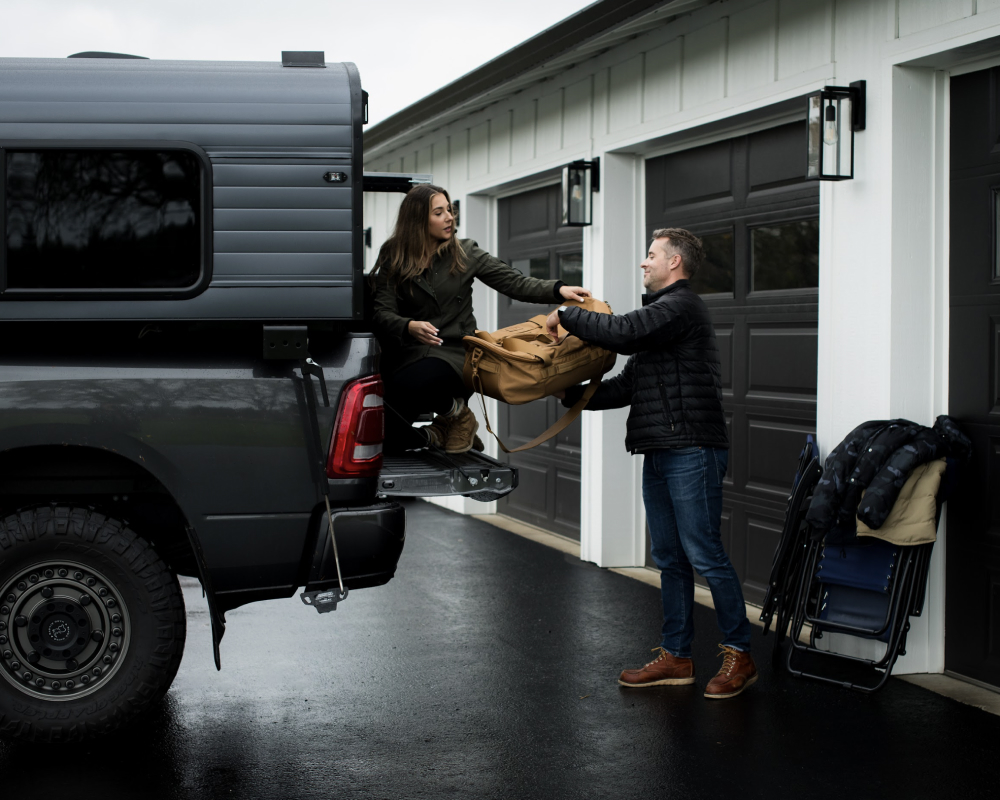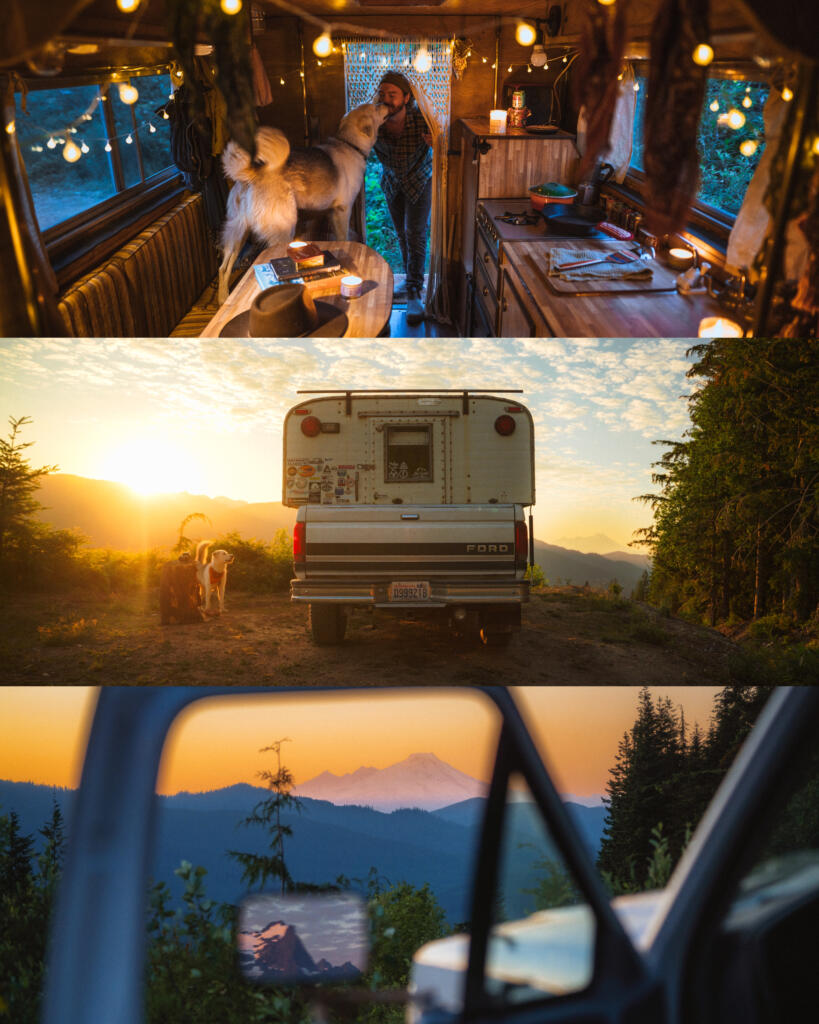Setting Up Your Alaskan at a Campsite
Organizing Gear and Prepping for Emergencies
By now, your Alaskan is likely well-stocked with supplies, but a thorough gear check before departure is essential. Trust us, discovering missing items during preparation is far better than realizing you left the lighters and fire-making supplies at home—it literally happened to us last time. If you’re planning a longer stay, it’s helpful to organize your supplies ‘by room’—such as kitchen, bedroom/bath, and garage gear—in labeled, stackable totes for easy access. While those 31-gallon totes are spacious, we recommend also bringing along smaller, 10-gallon totes so you’re not digging around searching for smaller items, like a first-aid kit. Even at campsites, it’s important to always have a comprehensive first-aid kit handy, equipped with bandages, antiseptic wipes, pain relievers, tweezers, scissors, adhesive tape, and any necessary personal/pet medications. As long as we’re talking emergencies, it’s wise not to rely on cell service and bring two-way radios, or a satellite phone, which can be lifesaving if you’re hiking or backpacking. It’s also smart to bring along navigation tools like maps, compasses, or GPS devices to avoid getting lost in remote areas and to help ensure you make it back safely.

Choosing the campsite
Take some time to scout your campsite and make sure to choose a spot sheltered from strong winds, ideally shielded by hills or trees, and position your camper’s entrance away from the wind. Pay attention to those trees, though, and try to avoid areas beneath dead limbs that pose a risk of falling—these deadfalls can be dangerous. You’re going to want to consider water access as well for drinking, washing dishes, and laundry. Spigots are common at well-equipped campsites, but not always guaranteed. Make sure you have an alternative water plan, just in case. Speaking of water, if you’re also setting up a tent outside your Alaskan for extra guests, try to opt for a spot that is elevated above the water table to avoid any issues with rainwater accumulation and ensure it’s relatively flat.
Building an Outdoor Oasis
Everyone has their unique approach to setting up camp, and we’ve gathered a few of our favorite tips to share with you. If you’re specifically interested in outdoor kitchen ideas, you’re in luck! We’ve got a detailed guide just for that—check it out here.
Lighting
A well-lit campsite is both safe and inviting. Start by marking tent stakes and cords with reflective tape to avoid nighttime mishaps. We’ve even heard of folks wrapping reflective tape around stakes or solar-powered driveway lights for some guidance around the entryway. For essential lighting, pack sturdy lanterns and ensure each camper has a headlamp or flashlight. For ambiance, drape your campsite with solar-powered string lights or battery-operated Christmas lights—both fun and functional. Choose waterproof versions to keep the party glowing, rain or shine. And don’t forget to add some citronella oil into the mix; it’s great for setting the mood and keeping the mosquitoes at bay!
Furniture
When planning for dining or games, don’t rely solely on the availability of a picnic table—bring along a collapsible, sturdy table just in case. Additionally, a comfortable hammock can provide a perfect spot for relaxation or serve as an alternative napping option. If you’re heading to a tree-scarce campground, consider packing a hammock stand, as they’re easy to break down and transport. For a glamping option, we’ve read that an inflatable couch (or two) is a touch of luxury in the wilderness and can really come in handy—just don’t forget to bring a patch kit. Now, let’s address the elephant in the room—camp chairs. Yes, it’s a surprisingly heated topic, so we’ll steer clear of brand endorsements. Just look for chairs that collapse and store easily. Options like rockers, oversized chairs, loveseats, and those with cupholders might catch your eye, but just remember, you often get what you pay for in terms of durability.
Rugs and Shade
Campsite rugs not only make your campsite look nicer, with their diverse colors and patterns they also provide practical benefits, too. They reduce dirt, sand, and mud in high-traffic areas such as the cooking zone or gaming corner, keeping your site cleaner. (During our last trip, our camp neighbors had a few artificial grass pads combined with those puzzle-piece gym mats to create a makeshift floor. Not a bad idea but probably takes up some space to store.) In any case, rugs act as insulators against the cold ground on brisk nights or the hot surface during sunny days, making everything more comfortable regardless of the weather. For cleaning, while a broom and dustpan work well, we’ve found that a portable hand vacuum is indispensable. Once we added it to our Alaskan’s kit, it became a permanent fixture—perfect for quick and easy cleanups.
Okay, we’ve got a few outdoor rugs packed—what about shade? In a pinch, tarps or a canopy can transform your camping experience. We’ve also used those portable tents you see at all the kid soccer games, some even come with mesh walls for bug protection. For a lighter option, string shade cloths between trees or poles over communal areas and coolers to protect your gear and keep folks comfortable.

Alaskan Camper Setup Videos
Beyond general camp setup, when arriving at a campsite with your Alaskan, there’s a few things to do. We’ve put together a series of easy-to-follow tutorial videos going through basic camp setup tips—take a look:
Until next time…
We’re not sure how to wrap this up but we thought we’d try some words that are more inspiring than our own. We’re huge admirers of John Muir, one of our nation’s renowned naturalists and conservationists, who famously advised,
Of all the paths you take in life, make sure a few are dirt.
Exhilarating stuff, right? So pack up, head out, and stay safe—we’re about to do the same.